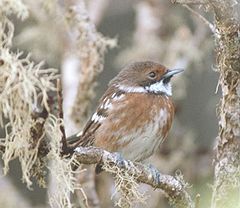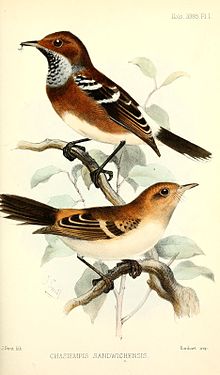- ‘Elepaio
-
For the journal published by the Hawaii Audubon Society, see ‘Elepaio (journal).
ʻElepaio 
Female Volcano ʻElepaio
Chasiempis sandwichensis ridgwayiConservation status Scientific classification Kingdom: Animalia Phylum: Chordata Class: Aves Subclass: Neornithes Infraclass: Neognathae Superorder: Neoaves Order: Passeriformes Suborder: Passeri Infraorder: Passerida Family: Monarchidae Genus: Chasiempis
Cabanis, 1847Species: C. sp. Binomial name Chasiempis sp.
(Gmelin, 1789)The ʻElepaio (Chasiempis sp.) is a complex of 3 species of monarch flycatcher that is endemic to Hawaiʻi. One species inhabits the Big Island, another Oʻahu and the third Kauaʻi. Being one of the most adaptable native birds of the archipelago, no subspecies have yet become extinct, though two have become quite rare nowadays.
The ʻelepaio is the first native bird to sing in the morning and the last to stop singing at night; apart from whistled and chattering contact and alarm calls, it is probably best known for its song, from which derives the common name: a pleasant and rather loud warble which sounds like e-le-PAI-o or ele-PAI-o. It nests between January and June.
Contents
Cultural significance
In Hawaiian tradition, the ʻelepaio was among the most celebrated of the birds.[2] It is associated with a number of significant roles in culture and mythology. Chiefly, it helped kālai waʻa (canoe-builders) to select the right koa tree to use for their waʻa (canoe). The ʻelepaio is a bold and curious little bird, and thus it was attracted to humans whom it found working in its habitat, and it quickly learned to exploit feeding opportunities created by human activity, altering its behavior accordingly [3] - which incidentally made it even more conspicuous.
For example, it followed canoe builders through dense vegetation, watching them as they searched for suitable trees. They considered it their guardian spirit, an incarnation of their patron goddess Lea, because if the bird pecked at a fallen tree, it was a sign that the tree was riddled with burrowing insects and thus not good anymore, but when the bird showed no interest in a tree, it indicated that the wood was suitable. This is the origin of the ancient Hawaiian proverb, ʻUā ʻelepaio ʻia ka waʻa ("The canoe is marked out by the ʻelepaio").
In addition, the bird was well liked for another reason - it was good to eat, and not subject to kapu restrictions. Due to its insectivorous habit, farmers believed the ʻelepaio to be the incarnation of Lea's sister goddess, Hina-puku-ʻai, who protected food plants and was a patron of agriculture.
As the bird was just as useful - perhaps even more useful - to humans alive as it was as food, overhunting of populations, while theoretically permissible under the kapu laws, did not usually occur. Additionally, although deforestation for agriculture destroyed some habitat, the ʻelepaio managed to adapt well to the initial settlement. Thus, its population was large enough to withstand the additional pressures that came about with Western colonization of the islands.
The three subspecies on the Big Island differ in their ecological requirements and head coloration (see also Gloger's Rule).[4]
- Big Island
- Chasiempis sandwichensis sandwichensis, the Kona,ʻElepaio. It differs from the Volcano subspecies by having the forehead and the supercilium whitish with some rusty feathers. It inhabits mesic forest characterized by koa (Acacia koa) and ʻōhiʻa lehua (Metrosideros polymorpha); its population seems to be stable at about 60,000-65,000.
- C. s. ridgwayi, the Volcano ʻlepaio. This is the most common subspecies today, with a population of around 100,000-150,000, or more than half of the total number of ʻelepaio. It is a bird of the rainforest, which on Hawaiʻi are characterized by ʻōhiʻa lehua and hāpuʻu (Cibotium tree ferns).
- C. s. bryani, the Mauna Kea ʻElepaio, is only found in the māmane (Sophora chrysophylla ) - naio (Myoporum sandwicense) dry forest on the leeward slopes of Mauna Kea. It has the entire head heavily washed with white. Due to destruction of most of its habitat, it is the rarest Big Island subspecies, with a population of 2,000-2,500 birds.
- Oʻahu
- C. ibidis, the Oʻahu ʻElepaio, is now restricted to an area of 47 square kilometres (18 sq mi) in the Koʻolau and Waiʻanae ranges,[5] where a fragmented population of 1,200-1,400 birds occurs. It is listed as endangered; avian malaria and fowlpox are widespread in the population and although it appears to have weathered the worst of it, it is still declining from a combination of these diseases and predation of nestlings, eggs and adult females by rats.[6] In areas where rats are controlled, survival and nest success are higher. This species looks very similar to ridgwayi, but the white underside extends to the flanks and further up the breast, and the upperside - especially the head - is more rust-colored.
- Kauaʻi
- C. sclateri, the Kauaʻi ʻElepaio numbered 40,000 around 1970, but declined by half in the 1990s. Whether this fluctuation is natural and thus the birds' numbers will rebound or whether it signifies a novel threat remains to be seen. This is the most distinct ʻelepaio; adult birds have their head and back grey, with a white supercilium, a rusty-red breast and a white underside. Young birds are uniformly rusty above and white below. Wings and tail are alike in all subspecies, but the young individuals of sclateri have the white stippling of the wings replaced by rusty coloration too.
Uniquely among Hawaiian passerines, the distribution of the ʻelepaio is peculiarly discontinuous. It does not - and judging from the lack of fossil remains, apparently never did - occur on Maui Nui or its successor islands. If this assumption is correct, the reasons are unknown at present. However, the strange "flycatcher finches", extinct honeycreepers of the genus Vangulifer, are only known to have inhabited Maui and probably evolved on Maui Nui.[7] There, they probably filled the same ecological niche as the ʻelepaio did on the other islands. Competition from Vangulifer may thus have prevented a successful colonization of Maui Nui by Chasiempis.
Footnotes
- ^ "Chasiempis sandwichensis". IUCN Red List of Threatened Species. Version 2009.2. International Union for Conservation of Nature. 2008. http://www.iucnredlist.org/apps/redlist/details/146952. Retrieved 30 January 2010.
- ^ Kanahele (1996): p.29, Soehren (1996): p.1
- ^ VanderWerf (1994)
- ^ Pratt (1980)
- ^ VanderWerf et al. (2001)
- ^ VanderWerf et al. (2006)
- ^ James & Olson (1991)
References
- Conant, S. (1977): The breeding biology of the Oahu ʻElepaio. Wilson Bull. 89(2): 193-210. DjVu fulltext PDF fulltext
- Kanahele, George S. (1996): Waikiki 100 B.C. to 1900 A.D. Honolulu: University of Hawaii Press.
- James, Helen F. & Olson, Storrs L. (1991): Descriptions of Thirty-Two New Species of Birds from the Hawaiian Islands: Part II. Passeriformes. Ornithological Monographs 46. PDF fulltext
- Pratt, H.D. (1980): Intra-island Variation in the ʻElepaio on the Island of Hawaiʻi. Condor 82(4): 449-458. DjVu fulltext PDF fulltext
- Soehren, Rick (1996): The Birdwatcher's Guide to Hawaiʻi. Honolulu: University of Hawaii Press.
- VanderWerf, Eric A. (1994): Intraspecific variation in foraging behavior of Elepaio in Hawaiian forests of different structure. Auk 111(4): 917–932. DjVu fulltext PDF fulltext
- VanderWerf, Eric A. (2001): Two-Year Delay in Plumage Maturation of Male and Female ʻElepaio. Condor 103(4): 756-766. DOI:10.1650/0010-5422(2001)103[0756:TYDIPM]2.0.CO;2 HTML abstract
- VanderWerf, Eric A. & Freed, Leonard A. (2003): ʻElepaio subadult plumages reduce aggression through graded status-signaling, not mimicry. Journal of Field Ornithology 74(4): 406–415. DOI:10.1648/0273-8570(2003)074[0406:ESPRAT]2.0.CO;2 HTML abstract
- VanderWerf, Eric A.; Rohrer, Joby L.; Smith, David G. & Burt, Matthew D. (2001): Current distribution and abundance of the Oʻahu ʻElepaio. Wilson Bull. 113(1): 10-16. DOI:10.1676/0043-5643(2001)113[0010:CDAAOT]2.0.CO;2 HTML abstract
- VanderWerf, Eric A.; Burt, Matthew D.; Rohrer, Joby L. & Mosher, Stephen M. (2006): Distribution and prevalence of mosquito-borne diseases in Oʻahu ʻElepaio [English with Spanish abstract]. Condor 108(4): 770-777. DOI:10.1650/0010-5422(2006)108[770:DAPOMD]2.0.CO;2 HTML abstract
- van Riper Charles III (1995): Ecology and breeding biology of the Hawaii elepaio (Chasiempis sandwichensis bryani). Condor 97(2): 512-527. DjVu fulltext PDF fulltext
External links
- ʻElepaio on the Audubon watch list. Contains a photo of sclateri, which shows the distinctness of that taxon well.
- BirdLife Species Factsheet.
Categories:- IUCN Red List vulnerable species
- Hawaiiana
- Hawaiian mythology
- Monarchidae
- Birds of Hawaii
- Endemic fauna of Hawaii
- Animals described in 1789
- Big Island
Wikimedia Foundation. 2010.


